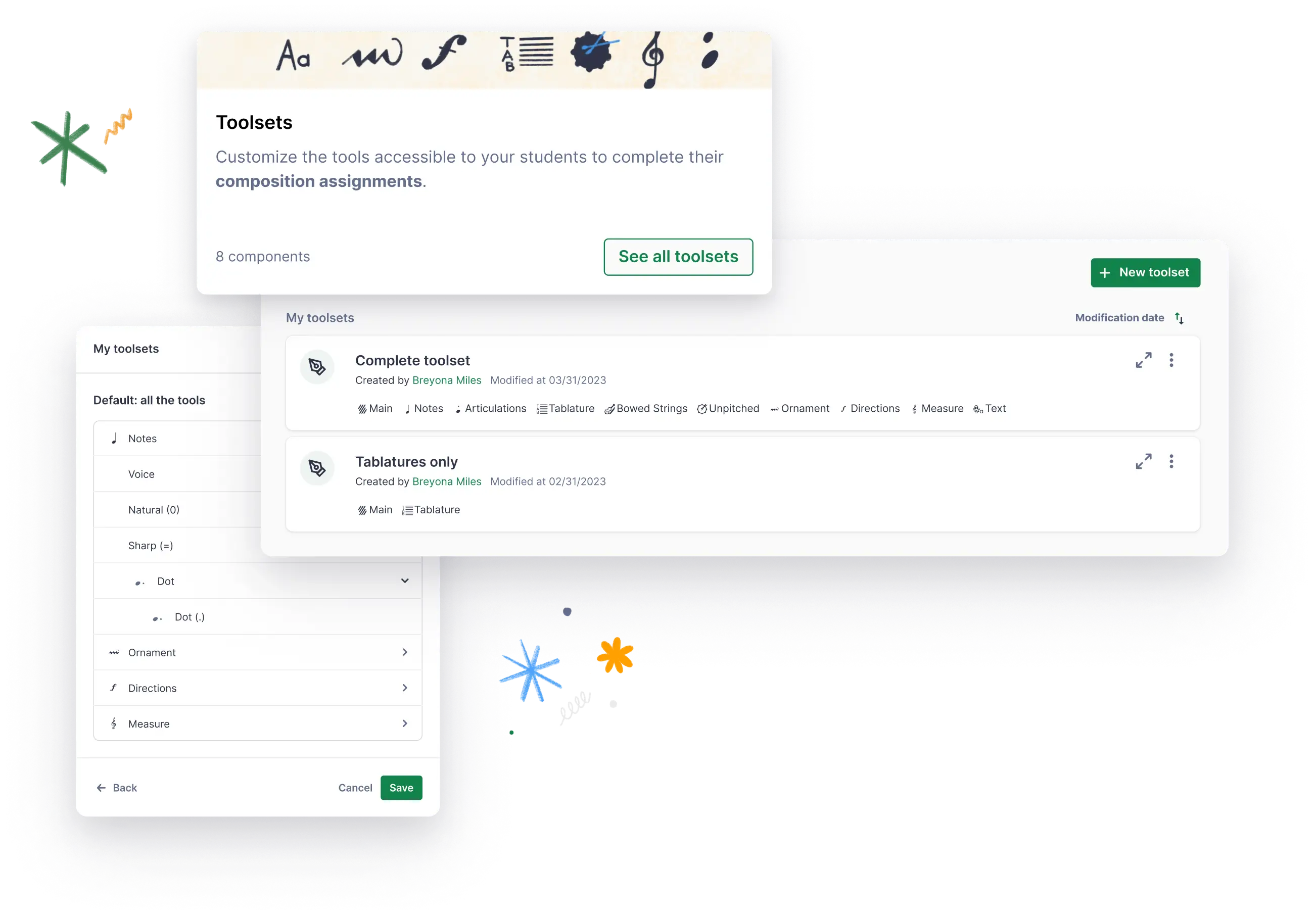Composition assignments are one of the most powerful ways to help students build musical understanding, creativity, and independence. Flat for Education, gives teachers a flexible, browser-based notation editor that supports composition, arranging, theory work, and collaborative writing across grade levels.
This guide shows you how to use composition assignments in your classroom, how to scaffold students with custom toolsets, how to incorporate Shared Writing, and how composition can connect to performance and literacy-based tasks.
Whether you teach general music, band, choir, songwriting, or orchestra, Flat for Education makes composition accessible for every learner.
*Tip: If you finish this article and still have questions, check out our Help page for more technical details on using Composition and Flat for Education in general. If you are interested in the video tutorials, please visit this link.
What Are Composition Assignments in Flat for Education?
A composition assignment allows students to create music directly in the notation editor, starting from a blank score or a template you choose. Teachers can customize:
- available tools
- instruments
- instructions
- collaboration settings
- playback limits
- assessment expectations
Students can compose individually or in groups, explore musical ideas, revise their work, and receive immediate auditory feedback.
A Mozart-inspired composition assignment using the colored notes feature
How to Create a Composition Assignment on Flat for Education?
- Open your My Assignments → New Assignment
- Select Composition
- Choose a template or start from a blank score
- Set instructions and learning goals
- Customize toolsets to simplify or expand the editor
- Assign to students individually or in groups
- Review submissions in real time
Flat for Education automatically saves progress, syncs across devices, and allows teachers to open any student score during class.
Collaborative Composition with Shared Writing
Shared Writing is a powerful Flat for Education feature that lets multiple students compose on the same score in real time. It is perfect for:
- small-group composition projects
- ensemble writing
- call-and-response creation
- thematic development
- songwriting
- differentiated instruction
- supporting neurodivergent students who thrive in structured collaboration
Teachers see every edit through version history and can comment directly on the score. Shared Writing turns composition into a fully collaborative learning experience.

Notation-Based Assignment Ideas (Beyond Composition)
Composition is only one way to use notation in Flat for Education. Here are additional notation-based activities that deepen skill development and prepare students for performance tasks:
1. Rhythm Creation and Variation
Students write a four-measure rhythm, then create two variations.
2. Melody Writing Challenges
Provide a starting motif or contour and ask students to extend it.
3. Error Detection (“Find the Mistakes”)
Use templates with intentionally incorrect rhythms, pitches, or articulations.
4. Arranging Tasks
Students assign a simple melody to different instruments or voicings.
5. Warm-Up or Technique Builders
Students write a short warm-up for their instrument section or voice part.
6. Score Analysis Activities
Have students annotate a piece by identifying form, intervals, or harmonic motion.
Connecting Composition to Performance Assignments
Composition and performance assignments work extremely well together. Teachers often:
- Have students compose a short melody
- Assign a performance task where students play, sing, or record the melody
- Use reflection prompts for students to compare what they wrote to how it sounded
- Combine both tasks into a portfolio entry
This sequence strengthens literacy, creativity, and instrumental/vocal technique.
Benefits of Using Composition Assignments
⭐ Controlled Creativity
Toolsets help students focus on specific rhythms, articulations, or techniques.
⭐ Real Musical Thinking
Students learn by making musical decisions, not by memorizing rules.
⭐ Variety for All Learners
Composition supports exploration, expression, and individualized pacing.
⭐ Playback for Instant Feedback
Students hear what they create, improving understanding of pitch, rhythm, and form.

Lesson Ideas for Different Grade Levels
Elementary
- Compose a “3-letter word melody” using A, B, C etc.
- Create a four-beat rhythm pattern and clap it for a classmate.
Middle School
- Build a two-measure motif, then develop it using repetition and sequence.
High School
- Reharmonize a simple melody
- Arrange a theme for different instrument groups
💡 Our YouTube channel features a Teacher Academy playlist designed to help you learn — and teach — with confidence.
Flat for Education Academy - Learn with confidence
A word from your fellow teachers
“My choir students range from future music majors to students who just want an “easy class", so designating time to write their own music can be challenging (since some want to create a masterpiece, others just want to meet the objectives as fast as possible). The greatest benefit has been that the students do enjoy getting to create their own music and the software levels the playing field a little bit in that you can hear what you write down rather than needing to know an instrument to hear what you're creating.”
– [C.J., Music Educator from the USA]
“With easy-to-set assignments & easy integration with our existing systems, I now use Flat for Education to set compositional tasks where students need to submit notation for assessment. Students are asked to arrange parts for varying instrumentalists, to develop their understanding of harmony, to re-harmonize, and more.”
– [M.D., Music Educator from the UK]
As always, if you have questions or feedback, please email us at edu@flat.io 💚
Musically Yours,
Flat for Education
